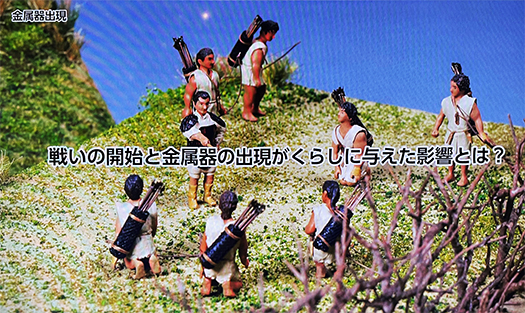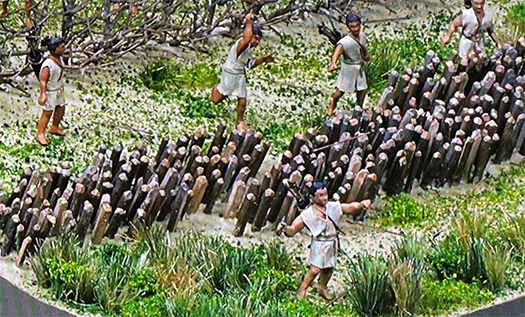


産経新聞はその出身者である司馬遼太郎の存在でもわかるように
文化部では日本史への取材の深みが蓄積されていると思う。
その2019年の記事で千葉県佐倉市の国立歴史民俗博物館(歴博)の
「先史時代および古代を扱う常設の第1展示室が、昭和58年の開館以来、
初めてリニューアルされた。」
という趣旨の記事が掲載されていた。遅ればせながら初めて知った。
「2019/3/25 14:00磨井慎吾」。まことに感染症の影響を実感。
〜日本列島に現生人類が出現した37,000年前から日本を国号とする
古代国家が成立した7~8世紀までの約36,000年間に及ぶ。
弥生時代の開始年代が約500年さかのぼるなど、先史時代を中心に
開館以降の36年間で大きく進歩した歴史研究の成果を反映させた、
大規模かつ意欲的な展示刷新。〜というリード。さらに
〜この30数年間、歴博は放射性炭素年代測定法などで多くの成果を生み出した。
(展示は)われわれが学んだ教科書で描かれた歴史像から大きく変わった」
今回の全面リニューアルの背景について、歴博の久留島浩館長はそう語る。〜
まさにわたしが感じていた展示リニューアルの衝撃を語ってくれている。
とくに「弥生」の開始が500年さかのぼる、という点が目を見張る。
展示されている内容は、きのうまで書いてきた内容なのだけれど、
展示から類推していけば、北部九州にやってきた水田耕作は
すでに「社会組織」ごと移動してきたような印象を感じさせてくれる。
高度な労働力組織化があって農業土木工事が行われている痕跡。
在地の縄文の人びとがこうした労役に参加したかどうか。
そしてきのう触れたようにコメ農耕の開始と同時期に「戦死者」も出現する。
農業土木と戦死痕跡には若干のタイムラグがあるようだが、
戦死痕跡の発見確率を考慮すれば、同時だったと考えた方が自然。
環濠集落という「城」の原初形態の出現とも考え合わせると、
弥生の農耕社会は、戦争と権力を揺籃したのだと確定できる。
こうした社会での争闘の普遍化は当然のように武力と権力機構の
過酷な進化・巨大化を促していったことも疑いがない。
そして紀元前3世紀には中国で秦の始皇帝という武力権力が成立する。
それ以前にも「殷」国家が存在しただろうけれど、東アジア世界一帯に
強大な強制力の恐怖が波動していったという意味で
農耕社会の基本原理=戦争という実相が極限的に露わになった。
たぶんそういう意味での「画時代的」な社会変動と認識されたに違いない。
日本の国家権力の草創は、こうした東アジアの戦争権力との相関関係が
もっとも大きな要因だったのだと思える。
成立した強大な武力権力に対してどのように対応すべきか、
このことは列島での人類進化上で、非常に大きなインパクトだっただろう。
農耕社会の進展で人口規模も幾何級数的に拡大して、
支配構造・祭政の要素が喫緊の社会課題になっていった。・・・
English version⬇
War is a Fundamental Principle of Agrarian Society: The 37,000-Year History of the Japanese Archipelago – 28
The development of productive forces also prompted the evolution of ritual power and violent devices to control them, and the societies of the archipelago were forced to respond. …
Sankei Shimbun, as evidenced by its native, Ryotaro Shiba.
I believe that the Culture Department has accumulated a depth of coverage of Japanese history.
In its 2019 article on the National Museum of Japanese History (Rekihaku) in Sakura City, Chiba Prefecture.
“The first permanent exhibition room dealing with prehistory and antiquity has been renovated for the first time since the museum opened in 1983.
“The first renovation since the museum’s opening in 1983.
I learned about it for the first time, albeit belatedly. I knew about it for the first time, though I was late.
I am very much aware of the effects of the infection. I really feel the effects of infectious diseases.
~37,000 years ago when the present humans appeared in the Japanese archipelago, and Japan as the country name.
The period covers about 36,000 years from the 7th to the 8th century when the ancient nation was established.
The museum focuses on prehistoric periods, including the Yayoi Period, which dates back about 500 years to the beginning of the Yayoi Period.
The museum has undergone a major and ambitious exhibition renewal, reflecting the results of historical research that has progressed significantly in the 36 years since the museum opened.
The museum has undergone a major and ambitious renovation of its exhibits, reflecting the results of significant advances in historical research over the 36 years since its opening. 〜The lead of the new exhibition is “The Yayoi Period” (1870-1900). In addition
〜The exhibition will be a major renewal of the museum’s collection, reflecting the great advances made in historical research over the past 36 years since the museum opened, particularly in the field of prehistory.
(The exhibits have changed dramatically from the image of history portrayed in the textbooks we have studied.
Rekihaku Director Hiroshi Kurushima explains the background behind the complete renewal of the museum. 〜The exhibition has been completely renewed.
This is exactly how I felt the impact of the renewal of the exhibition.
The fact that the “Yayoi period” dates back 500 years is particularly striking.
The contents of the exhibition are the same as those I have written about until yesterday.
By analogy with what I have already written yesterday, the paddy field cultivation that came to northern Kyushu
The exhibition gives us the impression that the paddy cultivators who came to Northern Kyushu had already moved with their “social organization” to the region.
There are traces of agricultural and civil engineering works with a high level of labor organization.
We wonder if the local Jomon people participated in this kind of labor.
As I mentioned yesterday, “war dead” appeared at the same time as rice cultivation began.
There seems to be a slight time lag between the agricultural engineering and the traces of war deaths.
However, considering the probability of finding traces of war deaths, it is more natural to assume that they occurred at the same time.
When combined with the appearance of the proto-form of “castles” called moat encircling settlements
We can conclude that the agricultural society of the Yayoi period was the cradle of war and power.
The universalization of warfare in such a society naturally led to the severe evolution and expansion of armed forces and power structures.
The universalization of conflict in such societies naturally led to the severe evolution and massive growth of military power and power structures.
In the 3rd century B.C., the military power of Qin Shi Huangdi was established in China.
Although the Shang state may have existed before then, the fear of a powerful coercive force would have been the wave that would have swept across the entire East Asian world.
In the sense that the fear of a powerful coercive force spread throughout the East Asian world.
The basic principle of agrarian society = the reality of warfare was exposed to the utmost limit.
Perhaps it must have been recognized as an “epochal” social change in this sense.
It seems to me that the most important factor in the pioneering of Japanese state power was its correlation with the war powers of East Asia.
The pioneering of Japanese state power was most likely due to this correlation with the war powers of East Asia.
The question of how to respond to the powerful armed forces that had been established in the East Asian region was a key question in the evolution of the human race in the archipelago.
This was probably the most important factor in the evolution of human beings in the archipelago.
As the size of the population expanded geometrically with the development of agrarian societies, the elements of the ruling structure and rituals became more and more important.
The elements of the ruling structure and ritual government became an urgent social issue. …
Posted on 11月 28th, 2022 by 三木 奎吾
Filed under: 日本社会・文化研究, 歴史探訪







コメントを投稿
「※誹謗中傷や、悪意のある書き込み、営利目的などのコメントを防ぐために、投稿された全てのコメントは一時的に保留されますのでご了承ください。」
You must be logged in to post a comment.